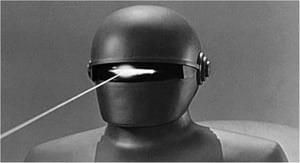
Before there were real robots, there was Gort, star of the greatest sci-fi movie ever. Gort wasn’t just a robot; it was an autonomous robot, or automaton. Gort was programmed to carry out a mission with perfect consistency and minimal direction, to serve its master unwaveringly. Gort symbolized a promise of automation that seemed already to be blossoming in 1950’s. On the dark side was the ever-present fear of the H-Bomb including the monthly drill of huddling under our school desks during a civil defense practice alert. (What confidence that instilled in school children!) And on the positive side there was a prediction of a “leisure society” in which the heavy lifting would be done by automatons like Gort while we humans enjoyed a three-day workweek.
The jury’s still out on the H-bomb problem, but it’s now clear that the futurists didn’t think the automation situation through very clearly. Nearly every product today incorporates some sort of autonomous function, and high-speed automated material and information processing is present in every industry. But the dream of the three-day workweek was dashed even before I entered the workforce. Today, in fact, there are two five-day workweeks, his and hers, and the days are often longer. I was resigned to this reality when I took my first job, but I was not fully aware of the implications of automation until my career path took me to the factory floor. There was not the primitive hand tool and simple machine operation that my father knew, but one where amazing high-speed machines produced parts and processed information faster than the eye could see. Modern wonders.
However, after becoming better acquainted with the shop floor and observing these machines more closely, I also became aware of their capability to produce the same defects as their human predecessors, only faster – much faster! On paper these modern wonders were deemed to be “no brainers.” But unlike Gort, they did not always serve their masters. Here a few examples:
- A surface mount line could produce hundreds of defective PC boards in the time the operator took to hit the stop button.
- A bottling machine was capable of filling at a blistering pace, five times faster than the upstream production, but took two hours to change over and jammed frequently.
- An automated hypodermic assembly machine was clad in Plexiglas shields because it sometimes shot errant parts in the operator’s direction.
These machines were fast, but not very flexible, not consistent, not always safe, and not at all forgiving of small tolerance swings in the parts they processed.
To be fair, the difficulties I mention were not the fault of automation, but emanated from the senseless manner in which automation was (is) deployed. In the first place, machine designers, assuming long runs, or even dedicated lines, did not make equipment easy to changeover. Servicing was also an arduous task, and once installed, machines were ill maintained to save money. Run-to-failure directives to optimize utilization and hit schedules caused band-aid fixes. In a short time these modern wonders had become modern day nightmares. A production employee quipped to me, “It’s fortunate this leadwire machine can out-produce the factory ten to one, because it’s either broken or making defects half the time.”
There are many reasons why the promise of automation is often not fulfilled, and there are lean countermeasures targeting each reason. I have difficulty sometimes describing these countermeasures in a piecemeal way, as in the abovementioned examples the following techniques would collaborate to generate better outcomes:
| Technique |
Outcome |
| Total Productive Maintenance (TPM) |
Equipment that consistently does the job we bought it to do. |
| Design for Six Sigma (DFSS) |
Parts that fit the machine and fit each other. |
| Autonomation |
Equipment that senses defects, and stops and alarms when they occur, freeing the employee from waiting by a single machine. |
| Standardized Work |
A clear, repeatable task for the employee who works with the equipment. |
| Set-up Reduction |
The ability to provide the right part in the right quantity at the right time. |
This list could certainly be extended, and it would be hard to say where one tool ends and another begins. They share two underlying principles, both at the heart of TPS:
- Provide value to the customer by eliminating non-value-added activities and multiplying productive capability.
- Respect the employee by providing meaningful, creative work.
Recently, I held a conversation with an employee at a packing line while he reflexively jumped in to clear jams or remove defects. He was so practiced at keeping the machine running that he could simultaneously clear jams and carry on a conversation. He knew where the problem points were. He had even developed a special tool to clear a particular jam that he couldn’t otherwise reach. His title was senior operator but he was really a professional jam clearer and defect remover. I asked him to describe his job. He quipped, “I’m a #@%& robot.”
When was the last time you watched your automation to look for improvement? Has your servant become your master? Please share your observations with us.
O.L.D.

